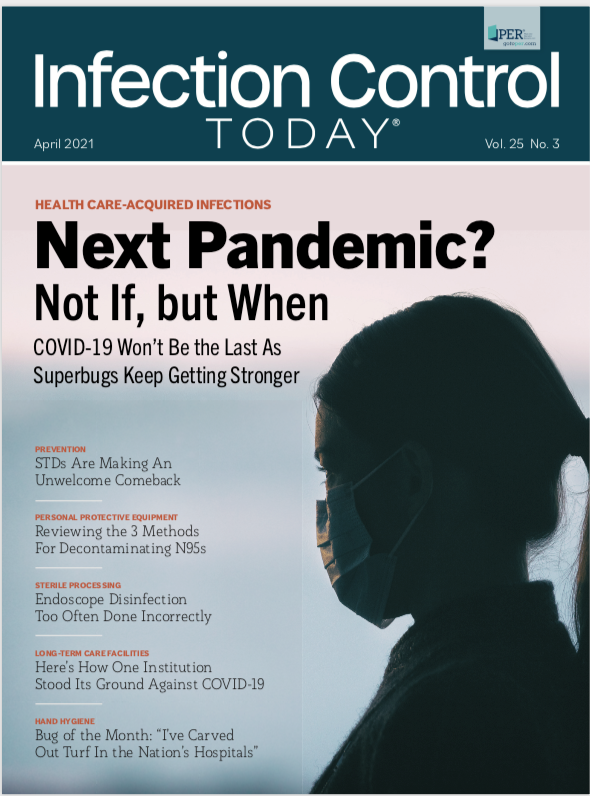Intense Infection Control Stops C. Auris Spread
“Infection control measures, including surveillance, education, cleaning/disinfection, patient cohorting, isolation, and hand hygiene, effectively contained the outbreak; it was declared over within 2 months.”
With mortality rates ranging anywhere from 30% to 60% and an ability to fight off most antibiotics, Candida auris has health care professionals sounding the alarm when they spot the superbug in their facility. Investigators with the University of British Columbia found that immediate implementation of stringent infection prevention and control measures at one hospital in the greater Vancouver area stopped the spread of this deadly fungal infection, limiting it to 4 patients. Investigators say that event was the first outbreak of C auris in Canada.
“Infection control measures, including surveillance, education, cleaning/disinfection, patient cohorting, isolation, and hand hygiene, effectively contained the outbreak; it was declared over within 2 months,” they write in a study in the American Journal of Infection Control (AJIC).1
According to the Centers for Disease Control and Prevention (CDC), the spread of C auris these days may be aided by all the attention given to coronavirus disease 2019 (COVID-19), and people with COVID-19 are particularly vulnerable2 to C auris.3
The outbreak in the AJIC study began at the 218-bed community hospital in August 2017. The first patient had just returned from India and went to the hospital for post-surgical complications for pancreatitis. C auris was found in ascitic fluid that was drained from the patient. Health care providers thought it resulted from colonization rather than infection. However, subsequently, 3 other patients—men from 61 to 89 years old—were found to have C auris.
“After the third case was identified, a decision was made in conjunction with the medical health officer for the region to declare an outbreak of C auris in the ICU of the facility,” the study states. “Efforts were undertaken to educate staff on the risks of transmission of the organism and reinforce standard infection control procedures.”
Staff from different departments huddled daily, and physicians conducted one-on-one education sessions with hospital employees.
“A multidisciplinary team was formed, which included representation from IPAC [infection prevention and control], public health, hospital communications and administration, clinical teams, and the BCCDC [British Columbia Centre for Disease Control],” the study states. “Daily debriefs and reports were dispersed by the IPAC team, while weekly meetings were held with the multidisciplinary team to communicate updates and coordinate further outbreak interventions. The team engaged national and international colleagues to solicit advice and support.”
As the CDC notes, one of the problems with battling C auris is that it can be difficult to spot.4 “Whole-genome sequencing conducted by our federal public health colleagues provided molecular epidemiological evidence linking the cases,” the study states. “It is unclear, however, as to how the C auris strain was introduced into the facility. One patient expired during the outbreak secondary to causes unrelated to C auris; the remaining patients were all eventually discharged home in
stable condition.”
The reason C auris often eludes detection is because laboratories sometimes have difficulty identifying the C auris yeast.
In this case, the yeast from the clinical specimens was identified as C auris using the Biotyper MALDI-TOF (6903 database). Then the isolates were forwarded to the provincial reference laboratory to confirm if the specimens were indeed C auris.
“At the time of the outbreak, there were no commercial selective media options available for screening of C auris,” the study states. “Screening swabs were planted to Brilliance Candida chromogenic agar (Oxoid Ltd, UK) and incubated in ambient air at 42.0 °C (107.6 °F) for 5 days.”
The plates were re-examined after 48 hours to see if there had been growth, and green and blue colonies were set aside because it was determined that they were not C auris.
“All beige, brown, or white colonies, which may represent a number of different Candida species, were identified using MALDI-TOF,” the study states. “Isolates with an acceptable MALDI-TOF identification score for species other than C auris were ignored. Any isolates identified as C auris were reported as presumptive C auris and forwarded to the provincial reference laboratory for confirmatory testing.”
The lab work confirmed the presence of C auris in time.
“In contrast to other outbreaks described in the literature, we were able to limit transmission to only 4 patients,” the study states. “Immediate infection control measures that were implemented included contact isolation, exclusive use of cleaning agents with sporicidal activity, contact tracing, weekly ward surveillance cultures, decluttering, frequent laundering of patient linens and gowns, and staff education. Later in the course of the outbreak, chlorhexidine washes of C auris-colonized patients were implemented, but it is unclear as to whether this contributed to the cessation of transmission.”
Investigators note how C auris represents not only a threat, but a growing threat.
“Our experience demonstrates that timely detection of the organism and rapid implementation of infection control measures are capable of limiting transmission; however, there are currently few guidelines to advise on strategies for effective admission screening protocols.”
REFERENCES:
- Eckbo EJ, Wong T, Bharat A, et al. First reported outbreak of the emerging pathogen Candida auris in Canada. Am J Infect Control. Published online January 20, 2021. doi:10.1016/j.ajic.2021.01.013
- Dyer, J. COVID unleashes the ‘lurking scourge’ Candida Auris. Infection Control Today.Published online November 11, 2020. https://www.infectioncontroltoday.com/view/covid-unleashes-the-lurking-scourge-candida-auris
- Fungal diseases and COVID-19. Centers for Disease Control and Prevention. Accessed January 29, 2021. https://www.cdc.gov/fungal/covid-fungal.html
- Candida auris: a drug-resistant germ that spreads in healthcare facilities. Centers for Disease Control and Prevention. Accessed January 29, 2021. https://www.cdc.gov/fungal/candida-auris/c-auris-drug-resistant.html
For more coverage based on industry expert insights and research, subscribe to the Infection Control Today® e-Newsletter here.

Bridging the Gap: Operating Room and Central Processing Unite to Improve Surgical Efficiency
April 8th 2025Communication breakdowns between the operating room and central processing led to delays and frustration—until collaboration, cross-training, and shared goals turned metrics around and strengthened teamwork.